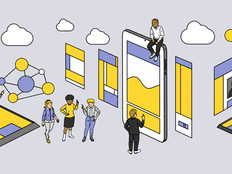Crowdsourcing Campus Health with Mobile Apps and Data
Tracking the seasonal flu is an onerous task. To accomplish it, the Centers for Disease Control and Prevention (CDC) compiles and analyzes reams of data, including virological surveillance from about 145 laboratories, information on outpatient visits from more than 2,900 healthcare providers, and mortality data from 122 cities.
Google Flu Trends, which compiles Internet searches related to flu, can often predict CDC findings one to two weeks in advance. Researchers at Johns Hopkins have compared Google Flu Trends to an early-warning system, allowing emergency rooms and healthcare providers to prepare for an uptick in patients before the CDC confirms the trend.
At the University of Wisconsin–Madison, infectious diseases researcher Ajay Sethi and doctoral candidate Christine Muganda saw the results of Google Flu Trends and wondered whether a smartphone app replicate those results.
Health: There’s an App for That
While Sethi has since uncovered similar projects, like Flu Near You and Sickweather, inspiration for his app OutSmart Flu came, in part, from an app with a very different focus: Waze, a community-based traffic and navigation app that lets users alert other users to road conditions.
Peak percentage of nationwide deaths attributed to flu and pneumonia during the 2012–2013 season
Waze users form a community, allowing them to report hazards and accidents through the app, which sends out updates to other users in the area. “It’s the same thing as high-beaming someone on a highway if you see a speed trap,” Sethi says.
Like Waze, OutSmart Flu appeals to users’ altruism. “It’s not unlike if you and I were to meet, and I wasn’t feeling well, and you put out your hand to shake mine. I might say, ‘You don’t want to touch me, I’m not feeling well.’” OutSmart Flu lets the UW–Madison community amplify that warning to a larger group.
Collecting Health Data in the Smartphone Age
Sethi and Muganda turned to Survey Analytics, which used its basic SurveySwipe app as the baseline, to create the OutSmart Flu app.”
“We have a number of university clients, but I don’t think we’d ever quite done anything with this kind of epidemiological slant,” Survey Analytics CEO Andrew Jeavons says. “The core functionality is around the ability to take mobile surveys, triggered based on geolocation.” One key feature is push notifications that encourage regular engagement with the app.
Greg Bender, the UW–Madison account manager at Survey Analytics, says the app comes with “a fairly robust reporting and analytics tool.” Clients can also export data in real time.
“It’s an open platform in that regard,” Bender says.
The Future of Disease Tracking
“The biggest advantage of direct reporting is that it is less susceptible to media interference,” says Robert Munro, CEO of Idibon, a data- and natural-language-processing firm. “One of the biggest things we’ve discovered looking at things like Google Flu Trends or social media is that while they do often correlate with actual outbreaks as an early signal, they can also be interfered with by the media.” When media coverage of an outbreak spikes, for instance, it frequently drives searches or tweets that distort the picture.
Other advantages with direct reporting include cleaner information and more finely grained data. The challenge of getting enough people to participate remains a marked disadvantage, however. And there’s also the matter of privacy: “Ultimately, the susceptibility of a person to getting colds and flus could be of interest to insurance companies, and there’s a real danger that it could affect insurance premiums.”
Although Sethi’s research is subject to stringent review by the university’s institutional review board and the data collected has personal information stripped prior to analysis, not every disease-related direct-reporting app will have to meet that high standard.
Ultimately, this flu season will help UW–Madison’s team answer a battery of questions about the utility of direct reporting of flu symptoms versus traditional CDC methods, as well as crowdsourcing based on search engine queries or social media mentions. Sethi says he hopes to learn how many participants are needed in a population, whether he can track an outbreak faster than the CDC with this app and whether users will value campus-level epidemiology. As a CDC sentinel cite, the university is an ideal testing ground.
“Direct reporting of people’s health state is absolutely the future of disease tracking,” Munro says.








